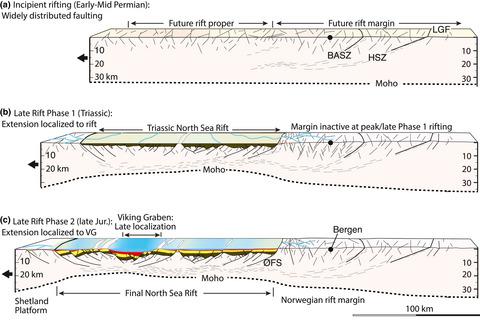当前位置:
X-MOL 学术
›
Basin Res.
›
论文详情
Our official English website, www.x-mol.net, welcomes your
feedback! (Note: you will need to create a separate account there.)
From widespread faulting to localised rifting: Evidence from K-Ar fault gouge dates from the Norwegian North Sea rift shoulder
Basin Research ( IF 2.8 ) Pub Date : 2021-01-16 , DOI: 10.1111/bre.12541 Haakon Fossen 1, 2 , Anna K. Ksienzyk 2, 3 , Atle Rotevatn 2 , Marit Stokke Bauck 4 , Klaus Wemmer 5
Basin Research ( IF 2.8 ) Pub Date : 2021-01-16 , DOI: 10.1111/bre.12541 Haakon Fossen 1, 2 , Anna K. Ksienzyk 2, 3 , Atle Rotevatn 2 , Marit Stokke Bauck 4 , Klaus Wemmer 5
Affiliation

|
Although seismic and stratigraphic well information put tight constraints on rift basin evolution, eroded rift shoulders commonly expose polydeformed prerift basement whose deformation history may be difficult to constrain. In this work, we apply K-Ar dating of fault gouge samples from 18 faults to explore the brittle deformation of the well-exposed eastern rift margin to the northern North Sea rift. We find evidence of clay gouge formation since the Late Devonian, with distinct Permian and Jurassic fault activity peaks that closely match early stages of the two well-established North Sea rift phases. A marked decay in fault density away from the rift margin confirms a close relationship between rifting and onshore faulting. The results show that initial rift-related extension affected a much wider area than the resulting offshore rift. Hence our data support a rift model where strain is initially distributed over a several 100 km wide region, as a prelude to the development of the ~150–200 km wide Permo-Triassic northern North Sea rift as defined by large marginal faults. Towards the end of the second rift phase, strain localises even more strongly to the 25–50 km wide Viking Graben. Interestingly, a period of early widespread extension is seen for both phases of North Sea rifting and may be a general characteristic of continental rifting. The documented prerift faulting and fracturing of the basement since the Devonian weakened the basement and probably facilitated the widespread initial extension that subsequently localised to form the northern North Sea rift, with further localisation to its relatively narrow central part (Viking Graben).
中文翻译:

从广泛的断层到局部裂谷:来自K-Ar断层泥的证据可以追溯到挪威北海裂谷
尽管地震和地层井信息对裂谷盆地的发展施加了严格的约束,但裂谷的裂谷肩部通常会暴露出多变形的预裂基底,其变形历史可能难以约束。在这项工作中,我们使用来自18个断层的断层泥样品的K-Ar测年来探讨暴露良好的东裂谷边缘到北海裂谷的脆性变形。我们发现了自泥盆纪晚期以来形成的粘土气孔的证据,具有明显的二叠纪和侏罗纪断层活动峰,与两个成熟的北海裂谷阶段的早期阶段非常匹配。断层密度远离裂谷边缘的明显衰减证实了裂谷作用与陆上断层之间的密切关系。结果表明,与裂谷有关的初始扩张影响的范围比由此产生的离岸裂谷更广泛。因此,我们的数据支持一种裂谷模型,该模型最初将应变分布在几百公里宽的区域内,以此作为发展由大型边缘断层定义的约150–200 km宽的Permo-Triassic北海裂谷的序幕。在第二个裂谷阶段即将结束时,应变更加强烈地局限在25至50公里宽的Viking Graben。有趣的是,北海裂谷的两个阶段都可以看到一个早期广泛扩展的时期,这可能是大陆裂谷的一个普遍特征。自泥盆纪削弱了基底以来,有据可查的基底的裂谷前断裂和破裂,并可能促进了广泛的初始扩展,随后扩展了该局部,形成了北海北部裂谷,并进一步定位到了其相对狭窄的中部(Viking Graben)。
更新日期:2021-01-16
中文翻译:

从广泛的断层到局部裂谷:来自K-Ar断层泥的证据可以追溯到挪威北海裂谷
尽管地震和地层井信息对裂谷盆地的发展施加了严格的约束,但裂谷的裂谷肩部通常会暴露出多变形的预裂基底,其变形历史可能难以约束。在这项工作中,我们使用来自18个断层的断层泥样品的K-Ar测年来探讨暴露良好的东裂谷边缘到北海裂谷的脆性变形。我们发现了自泥盆纪晚期以来形成的粘土气孔的证据,具有明显的二叠纪和侏罗纪断层活动峰,与两个成熟的北海裂谷阶段的早期阶段非常匹配。断层密度远离裂谷边缘的明显衰减证实了裂谷作用与陆上断层之间的密切关系。结果表明,与裂谷有关的初始扩张影响的范围比由此产生的离岸裂谷更广泛。因此,我们的数据支持一种裂谷模型,该模型最初将应变分布在几百公里宽的区域内,以此作为发展由大型边缘断层定义的约150–200 km宽的Permo-Triassic北海裂谷的序幕。在第二个裂谷阶段即将结束时,应变更加强烈地局限在25至50公里宽的Viking Graben。有趣的是,北海裂谷的两个阶段都可以看到一个早期广泛扩展的时期,这可能是大陆裂谷的一个普遍特征。自泥盆纪削弱了基底以来,有据可查的基底的裂谷前断裂和破裂,并可能促进了广泛的初始扩展,随后扩展了该局部,形成了北海北部裂谷,并进一步定位到了其相对狭窄的中部(Viking Graben)。











































 京公网安备 11010802027423号
京公网安备 11010802027423号